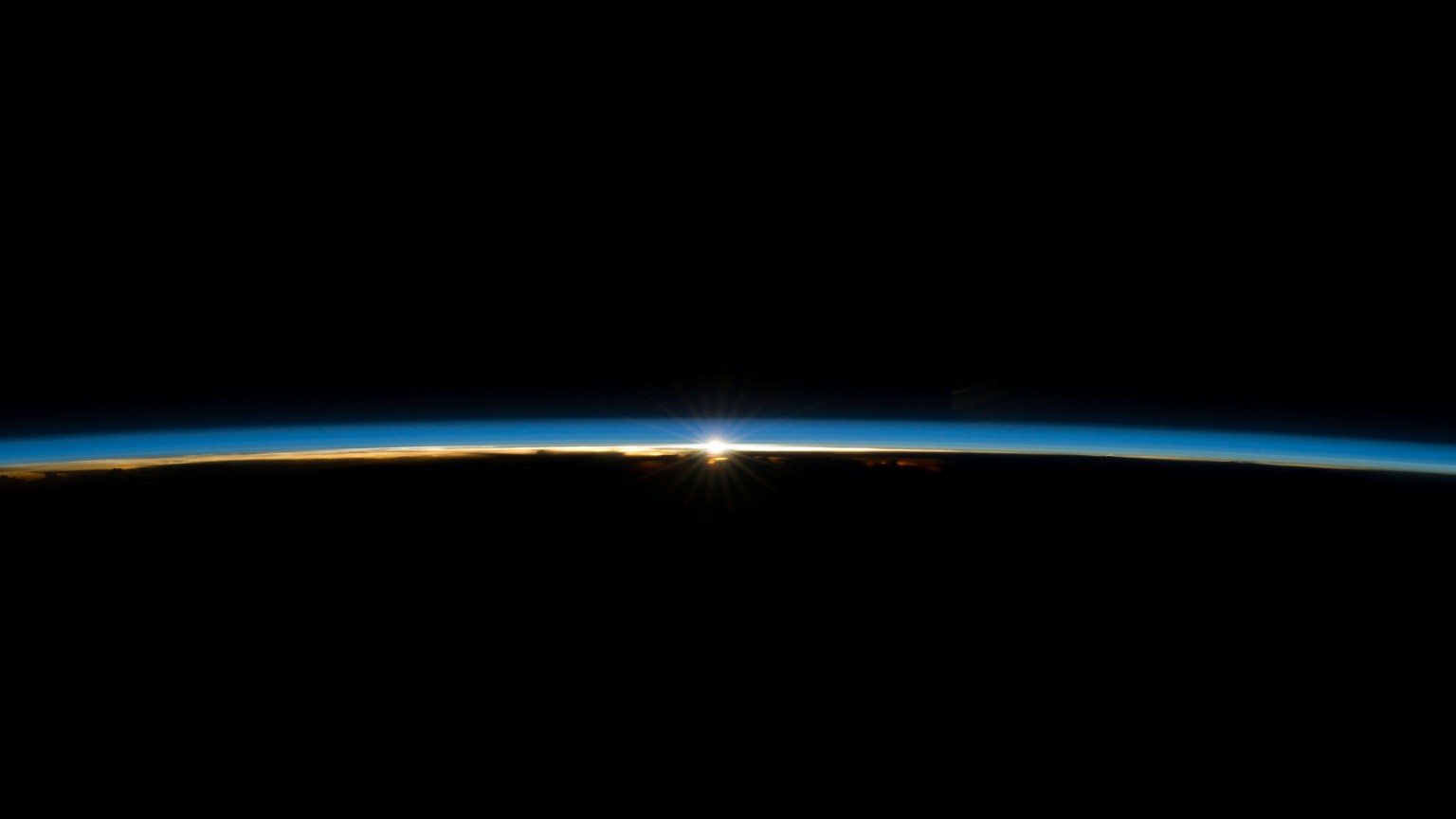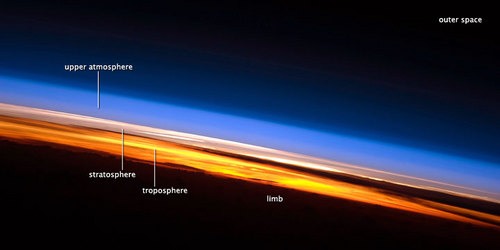Look at how thin our atmosphere is: Difference between revisions
Siterunner (talk | contribs) No edit summary |
Siterunner (talk | contribs) No edit summary |
||
| Line 27: | Line 27: | ||
[http://www.greenpolicy360.net/mw/images/How_thin_is_earth%27s_atmosphere.jpg '''''Look, "a twelve-minute drive" to the top of the troposphere...] | [http://www.greenpolicy360.net/mw/images/How_thin_is_earth%27s_atmosphere.jpg '''''Look, "a twelve-minute drive" to the top of the troposphere...] | ||
''Perspective... from an Astronaut's point of view the thinness of the Earth’s life-supporting envelope is clear to see. Yet, from the surface of the Earth, looking up, it is not clear at all how far the atmosphere goes. It is not clear how this 'thin blue' layer acts to protect our planetary ecosystems, our biosphere.'' | ''"Perspective... from an Astronaut's point of view the thinness of the Earth’s life-supporting envelope is clear to see. Yet, from the surface of the Earth, looking up, it is not clear at all how far the atmosphere goes. It is not clear how this 'thin blue' layer acts to protect our planetary ecosystems, our biosphere.'' | ||
''A collapse of the biosphere due to anthropogenic climate change is not an impossible scenario when seen with an overview perspective. The words of astronauts speaking of the thin layer of Earth's protective atmosphere are as if a modern Cassandra is warning without being heard or listened to by those too busy to hear...'' | ''"A collapse of the biosphere due to anthropogenic climate change is not an impossible scenario when seen with an overview perspective. The words of astronauts speaking of the thin layer of Earth's protective atmosphere are as if a modern Cassandra is warning without being heard or listened to by those too busy to hear..."'' | ||
''Let's talk in common language then, the language of cars and these cars are being driven up into the sky, not on highways to work or play. How far is it before we reach space | ''"Let's talk in common language then, the language of cars and these cars are being driven up into the sky, not on highways to work or play. How far is it before we reach the edge of space, the border to life as we know it down here on Earth? How can kids in schools get a lesson that simply says "the 'thin blue' atmosphere that protects life on Earth is at risk and needs to be carefully taken care of and preserved, healthy and sustainably vital..." -- SJS:Siterunner'' | ||
[[File:How thin is earth's atmosphere.jpg]] | [[File:How thin is earth's atmosphere.jpg]] | ||
Revision as of 13:34, 23 January 2016
"Look at how thin our atmosphere is. This is all there is between humankind and deadly space."
- ~ Astronaut Alexander Gerst
○ ○ ○ ○ ○ ○ ○ ○ ○ ○ ○ ○ ○ ○ ○ ○ ○ ○ ○ ○ ○ ○ ○ ○ ○ ○ ○ ○ ○ ○ ○ ○ ○ ○
- Environmental Security & The Thin Blue Layer
New Definitions of National Security: Environmental Security
A Thin Blue Layer ● A Thin Blue Layer protecting the home planet ● Thin Blue @ Pinterest ● Thin Blue @ Google+
"Thin Blue" -- a Global Trust, Earth's Atmosphere
A Moment of Thanks for Earth’s Atmosphere / On Thanksgiving, November 2014
○
Driving Up There, From Down Here
Look, "a twelve-minute drive" to the top of the troposphere...
"Perspective... from an Astronaut's point of view the thinness of the Earth’s life-supporting envelope is clear to see. Yet, from the surface of the Earth, looking up, it is not clear at all how far the atmosphere goes. It is not clear how this 'thin blue' layer acts to protect our planetary ecosystems, our biosphere.
"A collapse of the biosphere due to anthropogenic climate change is not an impossible scenario when seen with an overview perspective. The words of astronauts speaking of the thin layer of Earth's protective atmosphere are as if a modern Cassandra is warning without being heard or listened to by those too busy to hear..."
"Let's talk in common language then, the language of cars and these cars are being driven up into the sky, not on highways to work or play. How far is it before we reach the edge of space, the border to life as we know it down here on Earth? How can kids in schools get a lesson that simply says "the 'thin blue' atmosphere that protects life on Earth is at risk and needs to be carefully taken care of and preserved, healthy and sustainably vital..." -- SJS:Siterunner
○
Images revealing atmospheric 'height', a 'shallow troposphere', a narrow band of life-giving atmosphere surrounding Earth
http://www.greenpolicy360.net/mw/images/ISS_setting_moon.jpg
http://www.greenpolicy360.net/w/File:Earths_Atmospheric_Layers.JPG
○
One of the earliest known implications of space travel noticed by returned astronauts is what author Frank White has called the “Overview Effect.”
“For the first time in my life, I saw the horizon as a curved line. It was accentuated by a thin seam of dark blue light: the atmosphere,” said Ulf Merbold, a German astronaut who flew on Space Shuttle Columbia in 1983. “This was not the ‘ocean’ of air I had been told it was ... I was terrified by its fragile appearance.”
Frank White has made the overview effect a life philosophy. He’s helped found the Overview Institute, an organization dedicated to immersive space-related art and media that will allow the rest of us Earth-bound landlubbers to experience the transcendent insights that, until now, has been possibly only by space travel ...
○
Astronaut Gerst: Some things that on Earth we see in the news every day and thus almost tend to accept as a “given”, appear very different from our perspective. We do not see any borders from space. We just see a unique planet with a thin, fragile atmosphere, suspended in a vast and hostile darkness. From up here it is crystal clear that on Earth we are one humanity.
○
Atmospheric 'Experiment'
Atmosphere of Earth - Wiki Isn't It About Time? ... We are in the first era of geo-monitoring the thin blue atmosphere, earth systems and biosphere from space ... [1] [2]
Beginning with first-ever images of our home planet, Earth, taken from the Apollo era ... [3] [4]
Now follows #Earth360 continuing first-generation data and #sustainability realizations
An #EarthPOV, an "Overview" that, over time, will educate and open us to new challenges
Our generation welcomes new possibilities as citizens of the planet ...
○
Steven Schmidt / GP360 Siterunner: A chemical experiment with unknown consequences is taking place above and around us. The Earth's atmosphere, a thin layer that enables and protects life, is being impacted by potentially deadly human-produced emissions, even as a first generation of data and science is being produced with atmospheric observations from space. We are beginning to realize the extent of an existential experiment humanity is conducting in the atmosphere of the planet. The Anthropocene era is a gathering storm that is changing 'nature' as nature used to be.
○
Elon Musk: "The greater the change to the chemical composition of the physical, chemical makeup of the oceans and atmosphere [due to increased carbon emissions], the greater the long-term effect will be... [W]hy would you run this crazy experiment to see how bad it'll be? We know it's at least some bad, and the overwhelming scientific consensus is that it'll be really bad."
“Even if you put the environmental consequences of dramatically changing the chemical composition of the oceans and atmosphere aside, we will eventually run out of oil. If we don’t find a solution to burning oil for transport, and we then run out of oil, the economy will collapse and civilization will come to an end as we know it. And so if we know that we have to ultimately get off oil no matter what — we know that is an inescapable outcome, it’s simply a question of when, not if — then, why would you run this crazy experiment of changing the chemical composition of the atmosphere and oceans by adding enormous amounts of CO2 that’ve been buried since the pre-Cambrian era? That’s crazy. That is the dumbest experiment in history, by far. Can you think of a dumber experiment? I honestly cannot. What good could possibly come of it?” -- interviewed in an 2015 episode of Neil DeGrasse Tyson’s Star Talk
○
A "paper thin" layer absorbing the sum of human-produced hydrocarbon & emission "externalities"
File:Above Earth, 27.4 degrees south lat, 110.1 degrees west long.jpg
_ _ _ _ _ _ _ _ _ _ _ _ _ _ _ _ _ _ _ _ _ _ _ _ _ _ _ _ _ _ _ _ _ _ _ _ _ _ _ _ _ _ _ _ _ _ _
Tags: #BlueMarble; #Earth360; #EarthPOV; #OverviewEffect; #Troposphere; #ThinBlueLayer
◊
- Pages with broken file links
- Anthropocene
- Atmosphere
- Citizen Science
- Democratization of Space
- EOS eco Operating System
- Earth Observations
- Earth Science
- EarthPOV
- Earth360
- Environmental Full-cost Accounting
- Environmental Security
- Environmental Security, National Security
- Global Security
- National Security
- Networking
- New Space
- Planet Citizen
- Planet Scientist
- ThinBlueLayer
- Atmospheric Science
- Biogeosciences
- Climate Change
- Cryosphere
- Geophysics and Geochemistry
- Mineralogy
- Geology
- Geophysics
- Hydrology
- Natural Resources
- Ocean Science
- Planetary Science
- Space Science and Space Physics



